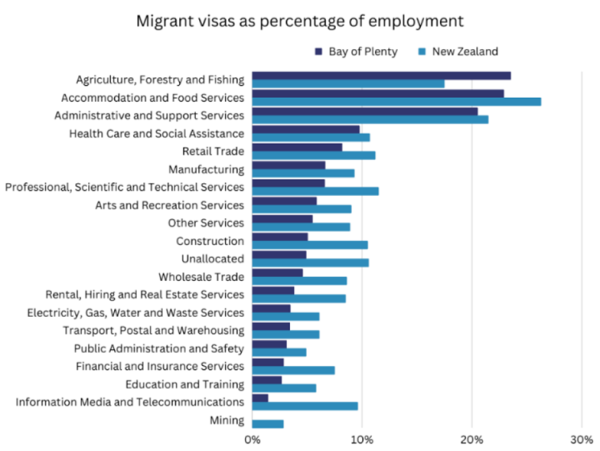Immigration
This section looks at immigration impacts on the Bay of Plenty labour market.
On this page
Key insights
Following the COVID-19 pandemic and the border closure, New Zealand experienced a net outflow of migrants and citizens. For instance, in 2021, there was a net loss of 15,000 people. This resulted in a reduction in the workforce across the whole country. However, by the second half of 2022, the situation began to change with a net migrant gain of 15,800 [7].
Figure 1: Migrant visas as percentage of employment

Text description of Figure 1: Migrant visas as percentage of employment
However, seasonal sectors such as horticulture and tourism need injections of labour during their peaks. Therefore, programmes like RSE are crucial to the region (see figure 1). Before the pandemic, approximately half of the horticulture workforce was made up of overseas workers. The impact of border closure was felt differently across different sub-regions. Some parts of the Bay of Plenty rely more on domestic and international tourism. For instance, Rotorua and Taupō, experienced an 81% and 76% drop in international spend, respectively, compared to this time last year, versus a 46% drop for the Western BOP (as of August 2021) [8].
Additionally, international education contributed $180M to the local economy with 2,000 students studying in the region in 2019. However, by 2021 this had dropped to 813 students [9]. This drop in enrolments has caused uncertainty about the future of the region’s international education and the loss of skills from the sector.
Our approach
The Regional Skills Leadership Group (RSLG) has begun focusing more deeply on immigration and how it can be responsibly and appropriately leveraged to ensure that the Bay of Plenty is better supported with its skill needs while ensuring equity across the labour market for our local communities.
To support this, the RSLG plans to engage further with priority sectors mentioned above around implementation of immigration settings and with immigration policy advocating for improved methods to help close labour market skills gaps at the local level. RSLG has also been engaging with local regional councils, including around Welcoming Communities Plans in place for the Western Bay of Plenty and Tauranga City [10] and Regional Partnership Agreements with Western Bay of Plenty Council, Tauranga City Council, Immigration New Zealand and Priority One [11] to drive forward workforce planning through council long-term plans and Immigration New Zealand.

90 Seconds
Key Regional Workforce Plan aspirations and actions that relate to Immigration
Seasonality aspiration
By identifying peaks and troughs and collaborating across sectors we hope to promote greater access to a range of flexible, secure, and stable opportunities that individuals/whānau can tailor to suit their needs. Due to the contract/piecemeal nature of the work, there is the potential for risk to worker conditions, and an accompanying aim will be to support sectors/ employers to mitigate this risk and combat work exploitation [12].
Seasonality actions
Undertake research to build a complete picture of the seasonality patterns across Bay of Plenty (including migrant workers) to confirm if under-employment is an opportunity area [13].
One potential way to confirm if there are unnecessary barriers to optimal use of skills is to look into the recent example of Cyclone Gabrielle and how migrant skills were leveraged to alleviate pressure on the horticulture sector. The RSLG is aware that the RSE scheme is being looked at around learnings to better use this type of scheme to alleviate workforce pressure and will seek to support this process [14].
New Recommendation
As part of the research action noted above, the RSLG will work to gain a clearer current understanding of how immigration is performing cross-regionally and cross-industry via data insights, sector engagement (including collation of regional plans/strategies). Use analysis to produce actionable insights to then advocate for policy that supports balanced and targeted immigration outcomes for the region.
[7] Return to net migration gains in 2022(external link) — Stats NZ, 16 February 2023
[8] Bay of Plenty Local Insights Report: October 2021(external link) — Bay of Plenty RSLG
[9] Bay of Plenty Local Insights Report: October 2021(external link) — Bay of Plenty RSLG
[10] Western Bay of Plenty Welcoming Communities Action Plan 2018 – 2020(external link) — Tauranga.govt.nz
[11] Western Bay of Plenty International Strategy 2019-2022 Summary Document(external link) — Tauranga.govt.nz
[12] Seasonality(external link) — Ministry of Business, Innovation and Employment
[13] Seasonality(external link) — Ministry of Business, Innovation and Employment
[14] Immigration Minister Michael Wood urgently reviewing to RSE scheme(external link) — Newshub, 22 February 2023

